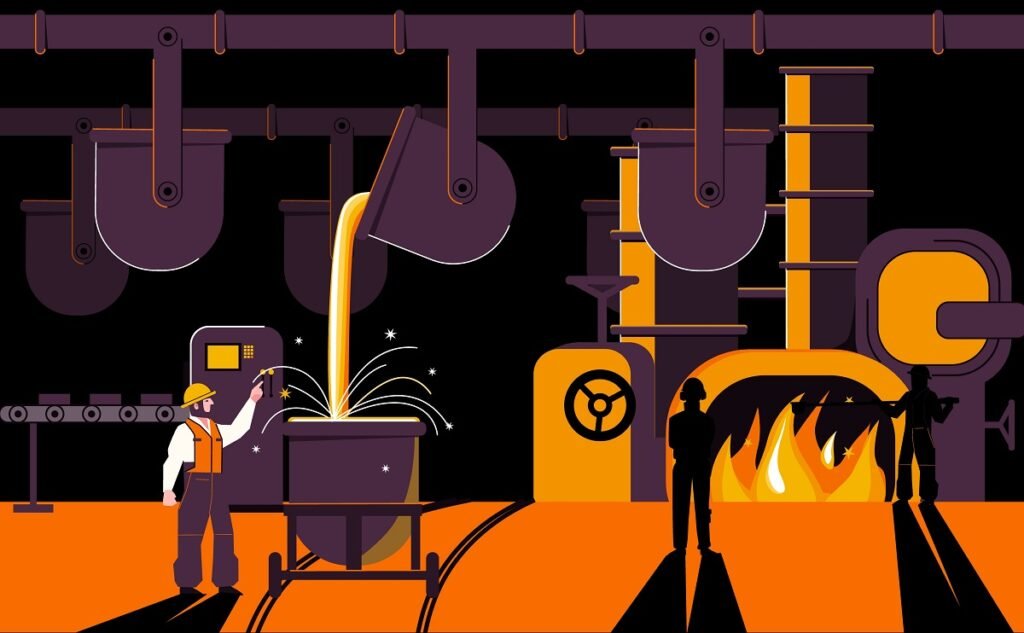Heat treatment is a crucial process in metal fabrication, altering metals’ physical and mechanical properties through controlled heating and cooling. Key techniques like annealing, quenching, and tempering enhance strength, durability, and performance for various applications, from automotive to construction. These processes manipulate metals at the molecular level, making them essential to modern manufacturing.
Annealing: Softening and Stress Relief
Annealing is a heat treatment process designed to soften metals, improve their ductility, and relieve internal stresses. This technique involves heating metal to a specific temperature and then cooling it slowly, allowing the material’s internal structure to reorganize and become more uniform.
Types of Annealing
The annealing process comes in several variations, each tailored for specific outcomes:
Full annealing heats steel to above its critical temperature, typically between 1600-1700°F for most carbon steels. The metal is held at this temperature until it reaches uniform heat distribution, then cooled slowly in the furnace. This process completely recrystallizes the metal’s grain structure.
Process annealing operates at lower temperatures, usually below the critical point. This technique is commonly used during manufacturing to restore ductility to work-hardened metals, allowing for continued forming operations without cracking.
Stress-relief annealing targets the removal of internal stresses without significantly changing the metal’s mechanical properties. This process uses moderate temperatures and is particularly valuable after welding or machining operations.
The Annealing Process
The annealing procedure follows three distinct stages. First, the metal is heated uniformly to the appropriate temperature based on its composition and desired outcome. The heating rate must be controlled to prevent thermal shock and ensure even temperature distribution throughout the material.
During the soaking stage, the metal is held at the target temperature for a predetermined time. This allows the internal structure to fully transform and stresses to dissipate. The duration depends on the material’s thickness and composition.
The final cooling stage is crucial for achieving desired properties. Slow cooling, typically accomplished by turning off the furnace and allowing natural cooling, prevents the formation of unwanted hard phases and ensures the metal remains soft and ductile.
Benefits and Applications
Annealing offers numerous advantages in metal processing. The process significantly improves ductility, making metals easier to form, bend, and machine. It reduces hardness to levels suitable for cutting and shaping operations. Internal stresses from previous manufacturing processes are relieved, preventing unexpected distortion during subsequent operations.
Industries rely on annealing for various applications. Automotive manufacturers use annealed steel for body panels that require extensive forming. Wire and cable producers anneal copper to improve its conductivity and workability. Tool manufacturers anneal steel before machining to reduce wear on cutting tools.
Quenching: Rapid Hardening
Quenching is a heat treatment process that rapidly cools heated metal to achieve maximum hardness and strength. This technique involves heating steel to high temperatures, then rapidly cooling it using various quenching mediums to trap carbon atoms in the iron lattice structure.
Quenching Mediums
The choice of quenching medium significantly impacts the cooling rate and final properties. Water quenching provides the most rapid cooling and maximum hardness but creates high internal stresses that may cause cracking in complex shapes or high-carbon steels.
Oil quenching offers moderate cooling rates with reduced risk of cracking and distortion. Different oils provide varying cooling characteristics, allowing metallurgists to fine-tune the hardening process for specific applications.
Air quenching uses forced air circulation for the slowest cooling rate among common methods. This technique works best with alloy steels designed for air hardening and produces less distortion but lower maximum hardness.
The Quenching Process
Successful quenching begins with heating the metal to its austenitizing temperature, typically 1450-1650°F for carbon steels. The metal must be held at this temperature long enough to dissolve carbon uniformly throughout the iron matrix.
The critical step involves rapid transfer from the heating source to the quenching medium. Speed is essential because any delay allows the steel to begin cooling slowly, reducing the effectiveness of the hardening process.
Immersion in the quenching medium must be swift and complete. The part should be agitated gently to ensure uniform cooling and prevent vapor blankets from forming on the surface, which could create soft spots.
Selecting Quenching Mediums
Medium selection depends on several factors including steel composition, part geometry, and required properties. High-carbon steels often require water quenching for maximum hardness, while alloy steels may achieve adequate hardness with oil quenching and reduced risk of cracking.
Complex geometries with varying thickness benefit from oil quenching to minimize distortion. Parts requiring precise dimensions often use polymer quenchants that can be adjusted for specific cooling rates.
Tempering: Balancing Hardness and Toughness
Tempering is the heat treatment process that follows quenching, designed to reduce brittleness while maintaining much of the hardness achieved during quenching. This critical step transforms the extremely hard but brittle martensitic structure into tempered martensite, which offers an optimal balance of hardness and toughness.
The Tempering Process
Tempering involves reheating quenched steel to temperatures typically ranging from 300-1200°F, depending on the desired final properties. The process begins immediately after quenching or after the parts have cooled to room temperature.
The steel is heated uniformly to the predetermined tempering temperature and held for a specific time period. Unlike annealing, tempering uses precise temperature control because even small variations can significantly affect final properties.
Cooling after tempering can be done in air for most applications. The cooling rate during tempering is less critical than during quenching since the primary structural changes occur during the heating and holding phases.
Importance After Quenching
Freshly quenched steel contains high internal stresses and exhibits extreme brittleness despite its impressive hardness. This combination makes the material unsuitable for most practical applications where impact resistance is required.
Tempering relieves these internal stresses while allowing some of the trapped carbon to precipitate in a controlled manner. This process reduces hardness slightly but dramatically improves toughness and impact resistance.
The tempering temperature directly controls the final properties. Lower temperatures preserve more hardness but provide less toughness improvement. Higher temperatures sacrifice more hardness but deliver superior toughness and ductility.
Applications in Manufacturing
Tempering applications span numerous industries. Cutting tools undergo tempering to achieve the right balance of hardness for edge retention and toughness to prevent chipping. Springs require tempering to develop the flexibility needed for repeated loading cycles while maintaining strength.
Automotive components like gears and shafts use tempering to achieve wear resistance with adequate toughness for shock loading. Metal casting services play a crucial role in producing these components with precision and durability. Construction hardware relies on tempered steel for tools and fasteners that must withstand both wear and impact.
Conclusion
Heat treatment processes like annealing, quenching, and tempering optimize metal properties by adjusting hardness, toughness, and workability. Precise temperature control and advanced monitoring are essential for producing high-performance products.



